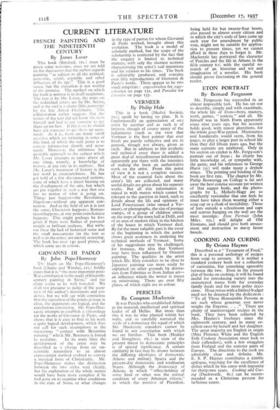CURRENT LITERATURE
FRENCH PAINTING AND THE NINETEENTH - CENTURY By James Laver
This book (Batsford, ars.) must be given some welcome, since we are told on the dust-cover that the author regards painting " as subject to all the political, economic, social, scientific and other influences of its age." This is a good omen, but the execution is not worthy of the promise. The method on which the book is written is in itself suspicious. The text is by Mr. Laver, the notes on the individual artists are by Mr. Sevier, and at the end is a chatty little postscript by the late Alfred Flechtheim. This collaboration rather suggests that the writer of the text did not know the facts himself and had to get someone to get them up for him. If this is so, he should have got someone to get them up accu- rately. As it is, there are many small mistakes which arc irritating in notes of this kind, of which the only point is to convey information shortly and accu- rately. Moreover, the ambitious but desirable approach to the subject which Mr. Laver attempts re,iuires above all one thing, namely, a knowledge of history, at any rate in its outlines. But Mr. Laver's treatment of history is the last word in amateurishness. He has got hold of a few disconnected notions, some of which have a direct bearing on the development of the arts, but which are put together in such a way that one has no notion of what is going on. Things just happen—the Revolution, Napoleon—without any apparent con-. nexion. And in the field of art it is just the same; Classicism happens ; Roman- ticism happens; at one point even Science happens. This might perhaps be for- given if there were flashes of personal insight or brilliant analyses. But with- out these the lack of historical sense and the small inaccuracies (in the text as well as in the notes) are merely annoying. The book has over 140 good plates, of which some are in colour.














































 Previous page
Previous page